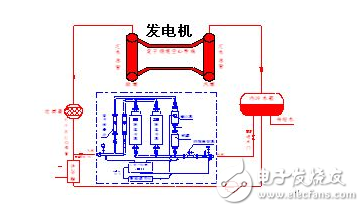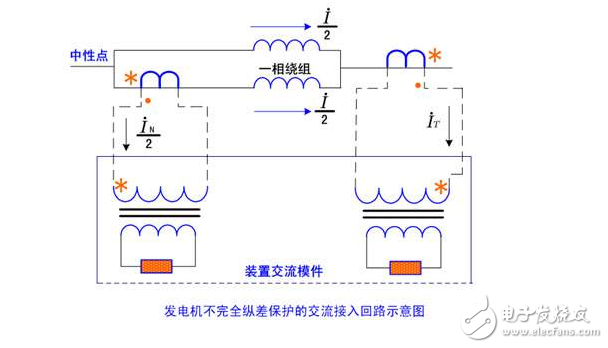The so-called phase-in operation of the generator means that the excitation current of the generator is reduced, so that the reactive output is below zero. In severe cases, the generator completely loses excitation. At this point, the generator will absorb reactive power from the grid, which will reduce the system voltage. When the large-capacity main unit in the system is in phase-in operation, it may cause system oscillation. If the generator excitation current is reduced and the generator potential is reduced, the power factor angle becomes advanced. The generator load current generates a magnetically assisted armature reaction, and the generator delivers active power to the system, but absorbs reactive power. The operating state is called the phase inbound operation. †1. Static stability is reduced; 2. The leakage current at the end causes the temperature of the stator end to rise; 3. The plant power supply voltage is reduced; 4. Due to the decrease of the terminal voltage, the stator current of the generator increases when the output power is constant, which is easy to cause overload. Sudden loss of excitation by synchronous generators is a common fault in power systems. The main reasons for the unit's loss of magnetism are: open circuit of excitation circuit, short circuit of excitation winding, failure of excitation regulator, false trip of degaussing switch and misoperation of operating personnel. After the synchronous generator is demagnetized, the excitation current of the unit rotor is gradually attenuated, and the generator is quickly transferred from the late phase operation to the in-phase operation, and is taken from the system when the original normal operation is transferred to the system to return to the system. No use. The reactive power drawn from the system is mainly used to establish the excitation of the unit. After the generator is demagnetized, the stator voltage of the machine will be significantly reduced, the system voltage will also be reduced, and the current of the electrical equipment in the system will increase. The main hazards of generator set loss-of-phase operation are as follows: 1) The stator current increases. When the generator set loses its magnetic asynchronous phase-in operation, the unit must draw a large amount of reactive power from the system, and the stator current will increase significantly. Because of the voltage drop, the stator current will be larger when the output of the unit is stable. It will cause the temperature rise of the stator to be higher than normal, and test the insulation heat resistance level of the unit. 2) The rotor is overheated and vibrated. When the generator loses magnetism and asynchronously enters phase, the stator also has a negative sequence magnetic field. The negative sequence magnetic field has a relative motion of the double synchronous speed of the rotor, so that twice the rated frequency (100 Hz) current is induced in the rotor winding and the rotor body, which will increase the rotor overheat level. These currents flow not only through the body of the rotor, but also through the guard ring, the groove and the teeth, and the many contact faces of the ferrule. These places have high electrical resistance and are particularly hot, which may cause local overheating and damage the mechanical strength and winding insulation of the rotor components. . Therefore, twice the frequency current causes the heat of the rotor to be particularly dangerous to the turbine generator. 3) The influence of the generator's loss of magnetic phase on the system voltage. After the generator is demagnetized, the reactive power is drawn from the system. It is mainly composed of two parts: one part is to provide the excitation and reactive power required by the motor; the other part is the reactive power consumed in the stator and rotor leakage reactance. If the single-unit capacity of the loss-free unit is large, the system capacity is small, the system voltage will drop significantly, and the power system will be out of step. With the asynchronous oscillation, the system will drop a lot of load and even cause the whole system to collapse. collapse. 4) Impact on other electrical equipment. Once the grid voltage is reduced, it will cause low-voltage tripping of the power equipment in the vicinity of the unit, such as the AC contactor low-voltage instantaneous release trip, the inverter equipment low-voltage protection trip, etc., which will affect the normal power consumption b]. Due to the failure of the excitation regulator, the unit loses its magnetic phase and enters the phase. In order to avoid long-term demagnetization of the unit, the operation mode and operation points of the excitation system of the generator set are formulated to avoid similar situations. 1) Excitation channel switching operation: Excitation channel switching is performed in place. Check that the excitation regulator unit A is in the “tracking†state, turn the local excitation cabinet “local/master†switch to the “local†position, and the “channel switching†switch from “channel B†to “channelâ€. Position, check the excitation regulator A "automatic operation" lights up, the "local / master" switch to the "master" position, the operation is completed. In principle, the excitation channel switching operation is not performed when there is no abnormality in the excitation system. 2) When the excitation channel is running or switching, the excitation regulator is switched to “manual operationâ€. Fault handling operation: Turn the “local/master†switch of the local excitation cabinet to the “local†position and adjust the “run†switch. Go to “Constant Power†or “Constant Power Factor†and then return to the “Constant Voltage†position. If the fault is not eliminated, perform the local excitation channel switching operation. 3) Magnetization/demagnetization operation: “Enhancement/Demagnetization†can be performed on the background monitor screen, or the “Local/Master†switch can be turned to the “Local†position and twisted “on the spotâ€. The magnetization/demagnetization knob completes the operation. The magnetization/demagnetization operation should not be too fast. 4) Excitation channel fault alarm Fault handling operation: Immediately check the excitation parameter change. If the generator outlet voltage has a large voltage drop such as 10kV or less, or the voltage has a continuous downward trend, the magnetization operation should be performed immediately. Press the “Reset†button of the excitation regulator on the spot (note that it is not the “Reset†button. Under normal circumstances, it is forbidden to press the “Reset†button) to eliminate the fault alarm. If the excitation channel alarm cannot be eliminated and the "magnetization/demagnetization" operation cannot be performed, the excitation channel switching operation is performed. 5) The operating personnel should pay attention to the reactive power output of the unit to prevent the unit from running for a long time in the phase-in phase. Once the reactive power “0 alarm signal appears, it should be gradually increased by switching channels or manually to ensure that the unit is not The power is between 4 and 12 MVar. 6) Loss of magnetic asynchronous operation allows the load and allowable duration to be clearly defined, ie O. 4 (only for rated power) allows continuous operation for 30 min; 0.5 Pn allows continuous operation for 15 min. In the event of a demagnetization of a generator operating at or near rated active power, measures should be taken to reduce the load quickly, and the active load must be reduced to the above allowable load within 30 seconds. Generator phase-in operation accident handling measures 1. The generator reactive power becomes negative. 2. The generator outlet voltage, 220kV bus voltage, and 6kV factory bus voltage are reduced. 3. The temperature of the stator coil and the temperature of the iron core at the end of the stator increase. Second, the generator phase operation processing: 1. Maintain normal system voltage and ensure system stability. When the network voltage is low, it is forbidden to enter phase. 2. When the phase is running, keep the generator outlet voltage within ±5%Un to prevent the generator static stability limit from decreasing. 3. Ensure that the generator cooling water temperature, water pressure and flow rate are within the rated parameters. 4. Monitor the temperature rise of the stator not exceeding the regulation, especially the temperature of the stator end does not exceed 120 °C. 5. During the phase-in operation of the generator, the temperature and temperature rise of each part exceed the operating limit, and the reactive load is manually increased. 6. During the phase-in operation of the generator, the generator stator voltage and stator current cannot exceed the operating limit, otherwise the contact scheduling will reduce the active power. 7. During the phase-in operation of the generator, the target phase depth target should be adjusted according to the schedule. When approaching a given depth, the operation should be fine-tuned smoothly, and the generator reactive power change and the 6kV factory bus voltage should be closely monitored. 8. During the phase-in operation of the generator, when the out-of-step oscillation occurs, the excitation current should be increased immediately until the phase is delayed. If necessary, reduce the active load, and still can not pull in the synchronization, according to the value of the length command to unpack the unit. 9. In the process of adjusting the depth of the phase advancement, attention should be paid to the reactive load of the adjacent units, and strive to be reasonably distributed. If the target phase depth target is adjusted to the main transformer high voltage side is still higher than the given voltage curve, the dispatch should be reported immediately and executed according to the command. 10. When the reactive load is adjusted to the given phase depth, the operating personnel should carefully monitor the disk, carefully adjust the operation and try to keep the operating conditions stable, and must not exceed the generator output curve and the V-shaped curve limit. Beware of a large change in the active load, resulting in a change in the depth of the reactive phase, which increases the power angle of the generator and exceeds the static stability limit. 11. During the phase-in operation of the generator, the temperature of each part of the generator is recorded every hour. 12. Generator phase-in operation If the reactive load, end temperature, and 6kV factory working bus voltage reach the limit condition, the excitation current should be immediately increased to the late phase stable operation, so that each limit condition is within the allowable range. The loss of magnetic phase-in operation will affect the stable operation of the generator's own equipment, causing system voltage fluctuations and causing the low-voltage protection action of some equipment in the network to trip. By strengthening the monitoring and management, some alarm measures are taken. Once the unit loses the phase into the phase, the load reduction or manual magnetization is adopted to improve the reactive output of the unit and reduce the impact on the system and the plant voltage. Therefore, the crew of the unit is required to pay close attention to the reactive output of the unit and avoid the long-term loss of phase of the unit.
On the premise of having mature motor design capabilities and high-precision process support capabilities (including automatic CNC metal processing technology, automatic high-speed precision motor stator and rotor punching production process lights), the low Servo Motor built by Kassel can be compatible with ac servo motors. The drive is perfectly matched to maximize the power and performance of the equipment, output unparalleled power density and motion control effects, simple and cost-effective.
Low Inertia Servo Motor,Low Inertia Motor,Low Inertia Servo Motor Control,Low Inertia Servo Motor Robot Kassel Machinery (zhejiang) Co., Ltd. , https://www.kasselservo.com
